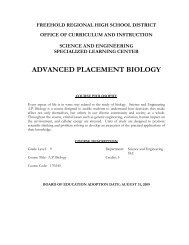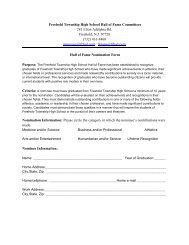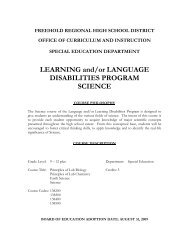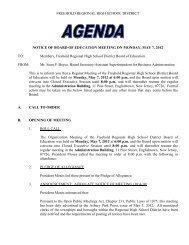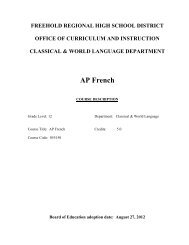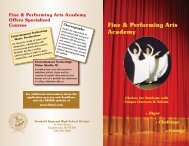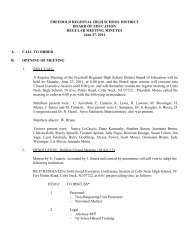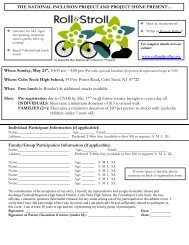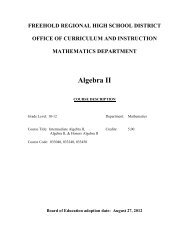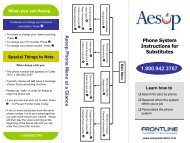PROBABILITY & STATISTICS - Freehold Regional High School District
PROBABILITY & STATISTICS - Freehold Regional High School District
PROBABILITY & STATISTICS - Freehold Regional High School District
You also want an ePaper? Increase the reach of your titles
YUMPU automatically turns print PDFs into web optimized ePapers that Google loves.
FREEHOLD REGIONAL HIGH SCHOOL DISTRICTOFFICE OF CURRICULUM AND INSTRUCTIONMATHEMATICS DEPARTMENT<strong>PROBABILITY</strong> & <strong>STATISTICS</strong>COURSE PHILOSOPHYIn order to avoid common errors in human judgment and decision-making, we rely onprobability and statistics to assist us in making informed decisions. The concepts learnedin an introductory statistics course are utilized often in myriad disciplines and form thefoundation for effective research.COURSE DESCRIPTIONGrade Level: 11-12 Department: MathematicsCourse Title: Probability & Statistics Credits: 5Course Code: 034900BOARD OF EDUCATION INITIAL ADOPTION DATE: AUGUST 30, 2010
Course PhilosophyWe live in a world where uncertainty is ever-present. In order to avoid common errors in human judgmentand decision-making, we rely on probability and statistics to assist us in making informed decisions. Theconcepts learned in an introductory statistics course are utilized often in myriad disciplines and form thefoundation for effective research. In an increasingly global world, the need for proper decision-making is ofparamount importance. Individuals must understand how to analyze and justify claims in all facets of life.Statistics provides that basis and is used in everything from public policy planning to research in thebehavioral sciences. Statistics is an essential component to a well-rounded education.Course DescriptionIn this course, students will learn the concepts that serve as the foundation for the study of probability andstatistics. Students will see how fields outside of mathematics use statistics to analyze and interpret data tomake informed decisions. With the assistance of technology such as the TI83/84 graphing calculator, theywill apply these concepts in myriad ways to critically analyze and synthesize information. This course mirrorsthat of a college level introductory statistics course, and as such students who dedicate an appropriate amountof study time will be prepared to take a similar course in college.
<strong>Freehold</strong> <strong>Regional</strong> <strong>High</strong> <strong>School</strong> <strong>District</strong>Curriculum MapProbability & StatisticsRelevantStandards 19.2 A1-5; B1-3;C1-24.4 A1-6EnduringUnderstandingsStatistics is necessaryto make accuratedecisions involvingdata.4.4 A 1-6 Proper experimentaldesign is necessary toensure non-biasedresults.8.1 A14.4 A 4-5, B 2;C 4Graphs produce visualdisplays of data inmeaningful ways.Essential QuestionsHow does one define statistics?Why is accurate decision making important?What are some implications of the inappropriate use ofdata?What considerations should be made when designing anexperiment?What does it mean for results to be considered biased?How do graphs enhance the display of data?How does one know which graph is appropriate to use for agiven set of data?Diagnostic(before)PretestStudent SurveyOral Questions/DiscussionAnticipatory SetQuestionsAssessmentsFormative(during)JournalsQuizzesChapter TestWritten AssignmentsOral PresentationsObservationsParticipatory RubricsResearchAssignmentsSummative(after)PortfoliosProjectsMid TermsFinal Exam4.4 A 5 Measuring the spreadof data is essential forcomparing data sets.Why does one need to analyze the spread of data?In what situations might it be useful to compare the spread ofdata?4.4 B 1-6; C 1-4 Probability describesthe likelihood an eventwill occur.How is probability used in everyday life?How does the study of probability integrate itself into the studyof statistics?4.4 A 5 The distribution ofoutcomes of many reallife events can beapproximated by thenormal curve.What is a normal curve?Why is an understanding of the normal curve essential tostatistics?In what situations can the normal curve be applied to data?4
RelevantStandards 1EnduringUnderstandings4.4 A 2, 5; B 5-6 The larger the sample,the more accurate thedata is when mappedonto a population.4.4 A 2-4; B 5 Claims must berigorously tested againstquantitative sets ofstandards.What is a confidence interval?Essential QuestionsWhy is it necessary to apply confidence intervals whenattempting to generalize results of a sample to the populationin the aggregate?What is hypothesis testing?What is the value in using hypothesis testing when trying tovalidate a claim?Diagnostic(before)PretestStudent SurveyOral Questions/DiscussionAnticipatory SetQuestionsAssessmentsFormative(during)JournalsQuizzesChapter TestWritten AssignmentsOral PresentationsObservationsSummative(after)PortfoliosProjectsMid TermsFinal Exam8.1 A 14.4 A 4Modeling an equation todata allows one topredict future behavior.What is regression analysis?What are the benefits of using an equation to model data?Participatory RubricsResearchHow does one know how well an equation models a set ofdata?Assignments4.4 A 2 To determine if two datasets affect each other,Chi-Square analysis isused.Why might it be necessary to determine if there is a differencebetween two data sets?What does it mean for two data sets to be consideredindependent?8.1A 1-3 ; B 1;D 29.1 B 1; E 1-2Technology is integral tothe study of statistics.Why is it important to understand hypothesis testing prior tousing Chi-Square?What types of technology is used for statistical analysis?In what ways can technology be useful when designing yourown experiment?5
<strong>Freehold</strong> <strong>Regional</strong> <strong>High</strong> <strong>School</strong> <strong>District</strong>Course Proficiencies and PacingProbability & StatisticsUnit Title Unit Understandings and Goals RecommendedDurationUnit #1: What is Statistics?Unit #2: Statistical GraphsUnit #3: Measures of CentralTendencyUnit #4: ProbabilityUnit #5: The Normal CurveUnit #6: Confidence IntervalsUnit #7: Hypothesis TestingUnit #8: Regression AnalysisStatistics is necessary to make accurate decisions involving data.Proper experimental design is necessary to ensure non-biased results.1. Students will examine the role of statistics in decision making processes.2. Students will define the necessary steps to ensure proper experimental design and critiquecurrent published research for hidden biases.Graphs produce visual displays of data in meaningful ways.1. Students will decide which statistical graph best fits a given set of data.2. Students will synthesize various types of graphs for given data sets.Measuring the spread of data is essential for comparing data sets.1. Students will utilize various methods of central tendency to determine the spread of data.2. Students will determine whether they are working with a sample or a population and utilize theappropriate formulae to measure central tendencies.Probability describes the likelihood an event will occur.1. Students will examine the role of probability in everyday life.2. Students will utilize probability to determine the likelihood of outcomes in myriad situations.The distribution of outcomes of many real life events can be approximated by the normal curve.1. Students will utilize the area under the Normal Curve to answer probabilistic questions.2. Students will apply the Central Limit Theorem to determine the likelihood of the occurrence ofan event.The larger the sample, the more accurate the data is when mapped onto a population.1. Students will employ the use of confidence intervals to determine the likelihood of a populationmean being between a certain set of values.2. Students will apply the concepts of confidence intervals to determine differences between twopopulation means.Claims must be rigorously tested against quantitative sets of standards.1. Students will decide whether to reject or fail to reject a claim by using hypothesis testing.2. Students will determine whether the data fits a mean or a proportion, and then utilizeappropriate testing methods.Modeling an equation to data allows one to predict future behavior.1. Students will synthesize scatter diagrams to determine if linear correlation exists.2. Students will determine how a population correlation coefficient fits a set of data usinghypothesis testing.2 weeks2 weeks3 weeks5 weeks4 weeks4 weeks5 weeks3 weeks6
Unit Title Unit Understandings and Goals RecommendedDurationUnit #9: Chi-Square AnalysisUnit #10: Independent ProjectsTo determine if two data sets affect each other, Chi-Square analysis is used.1. Students will determine if independence exists between two sets of data by utilizing the Chi-Square Test for Independence.2. Students will determine if significant differences exists between two data sets by using Chi-Square Goodness-of-Fit test.Technology is integral to the study of statistics.Proper experimental design is necessary to ensure non-biased results.1. Students will create a project utilizing many of the topics covered in the course.2. Students will utilize technology, such as spreadsheets, graphing calculators, and graphingsoftware to analyze data and create their project.3 weeks3 weeks7
<strong>Freehold</strong> <strong>Regional</strong> <strong>High</strong> <strong>School</strong> <strong>District</strong>Probability & StatisticsUnit #1: What is Statistics?Enduring Understandings: Statistics is necessary to make accurate decisions involving data.Proper experimental design is necessary to ensure non-biased results.Essential Questions: How does one define statistics? Why is accurate decision making important?What are some implications of the inappropriate use of data? What considerations should be made when designingan experiment? What does it mean for results to be considered biased?Unit Goals: Students will examine the role of statistics in decision making processes.Students will define the necessary steps to ensure proper experimental design and critique current published research for hidden biases.Duration of Unit: 2 weeksNJCCCS: 8.1 A1, 9.2 A1-5; B1-3; C1-2; D1-5, 4.4 A1-6Guiding / Topical QuestionsWhat are the two types of statistics?What is the difference between a sample and apopulation?What are the different levels of measurementthat can be applied to data?What is involved in ensuring properexperimental design?How can one truly ensure a selection of randomsamples?What does it mean for an experiment to bebiased?What is a double-blind experiment and how arethey used?What is a placebo effect?Content, Themes, Concepts, and SkillsDescriptive statistics involves methods of organizing, picturing, and summarizinginformation from data.Inferential statistics uses samples to make inferences about a population.Define a sample and a population and show examples of each.Define the four levels of measurement: nominal, ordinal, interval, and ratio.List steps necessary to follow when creating an experiment.Show how to use a random number table and how to generate a random number on thegraphing calculator.Define bias and show examples of how bias may be introduced.Define a double-blind experiment and show how it is used.Define placebo effect with an example.InstructionalResourcesandMaterialsCurrent textbookand resourcebindersInternetMagazinesNewspapersVideosGraphingCalculatorsTeachingStrategiesLecture and classdiscussionComplete thechapter studyguidesStudentinvestigationactivitiesAssessmentStrategiesWritten tests andquizzesWorksheetsProject assessmentsNotebookassessmentsResponses todiscussion questionsJournal assessmentsStudent responsesystems for immediatefeedbackSuggestions on how to differentiate in this unit:• Students will work individually, engage in cooperative learning, and utilize discovery learning on certain activities.• Through the use of lectures, the internet, and interactive whiteboards, students will be exposed to various teaching methods to appeal to visual, auditory, and kinesthetic learners.• Students will be given copies of data sets and other important notes.8
<strong>Freehold</strong> <strong>Regional</strong> <strong>High</strong> <strong>School</strong> <strong>District</strong>Probability & StatisticsUnit #2: Statistical GraphsEnduring Understandings: Graphs produce visual displays of data in meaningful ways.Essential Questions: How do graphs enhance the display of data?How does one know which graph is appropriate to use for a given set of data?Unit Goals: Students will decide which statistical graph best fits a given set of data.Students will synthesize various types of graphs for given data sets.Duration of Unit: 2 weeksNJCCCS: 8.1 A1, 4.4 A 4-5; B 2; C 4Guiding / TopicalQuestionsWhat is a bar graph?What are the differences betweena bar graph and a Pareto chart?Why is a correct scale importantwhen creating graphs?Content, Themes, Concepts, and SkillsDefine and provide examples of bar graphs.Define the characteristics of a Pareto chart and compareand contrast to bar graphs.Explain the use of the break and show examples of graphswith inconsistent scales to emphasize importance ofcorrect scales.InstructionalResources andMaterialsCurrent textbook andresource bindersInternetMagazinesNewspapersVideosTeachingStrategiesLecture and classdiscussionComplete thechapter study guidesStudent investigationactivitiesAssessment StrategiesWritten tests and quizzesWorksheetsProject assessmentsNotebook assessmentsResponses to discussionquestionsWhat is a circle graph and howare they created?What is a time-series graph?Define and create circle graphs.Create and define a time-series graph.Graphing CalculatorsJournal assessmentsStudent response systemsfor immediate feedbackWhat is a histogram and how is itdifferent from a bar graph?Delineate the steps in creating a histogram whileemphasizing the differences between it and a bar graph.How is data ordered using astem-and-leaf plot?Define and create a stem-and-leaf plot.Suggestions on how to differentiate in this unit:• Students will work individually, engage in cooperative learning, and utilize discovery learning on certain activities.• Through the use of lectures, the internet, and interactive whiteboards, students will be exposed to various teaching methods to appeal to visual, auditory, andkinesthetic learners.• Students will be given copies of data sets and other important notes.• Students can create graphs on poster board to hang in the classroom.9
<strong>Freehold</strong> <strong>Regional</strong> <strong>High</strong> <strong>School</strong> <strong>District</strong>Probability & StatisticsUnit #3: Measure of Central TendencyEnduring Understanding: Measuring the spread of data is essential for comparing data sets.Essential Questions: Why does one need to analyze the spread of data?In what situations might it be useful to compare the spread of data?Unit Goals: Students will utilize various methods of central tendency to determine the spread of data.Students will determine whether they are working with a sample or a population and utilize the appropriate formulae to measure centraltendencies.Duration of Unit: 3 weeksNJCCCS: 4.4 A 5Guiding / Topical QuestionsHow do mean, median, and mode relateto the concept of central tendency?In what situations would a trimmedmean be preferable to a regular mean?How does one find an average whenvalues have different weights?What are some limiting factors whenusing mean, median, and mode todescribe data?How does standard deviation relate tothe spread of data?Content, Themes, Concepts, and SkillsDefine mean, median, and mode.Define trimmed mean and explain its use whendealing with outliers.Define weighted average.Introduce and define the concepts of standarddeviation and variance.Define Chebyshev’s Theorem and its use indetermining percentages of data within a set numberof standard deviations.InstructionalResources andMaterialsCurrent textbook andresource bindersInternetMagazinesNewspapersVideosGraphing CalculatorsTeachingStrategiesLecture and classdiscussionComplete thechapter study guidesStudent investigationactivitiesAssessment StrategiesWritten tests and quizzesWorksheetsProject assessmentsNotebook assessmentsResponses to discussionquestionsJournal assessmentsStudent response systemsfor immediate feedbackHow does the median relate topercentiles?Establish the median is the 50 th percentile and thenuse box-and-whisker plots to visualize the remainingpercentiles.Suggestions on how to differentiate in this unit:• Students will work individually, engage in cooperative learning, and utilize discovery learning on certain activities.• Through the use of lectures, the internet, and interactive whiteboards, students will be exposed to various teaching methods to appeal to visual, auditory, andkinesthetic learners.• Students will be given copies of data sets and other important notes.10
<strong>Freehold</strong> <strong>Regional</strong> <strong>High</strong> <strong>School</strong> <strong>District</strong>Probability & StatisticsUnit #4: ProbabilityEnduring Understanding: Probability describes the likelihood an event will occur.Essential Questions: How is probability used in everyday life?How does the study of probability integrate itself into the study of statistics?Unit Goals: Students will examine the role of probability in everyday life.Students will utilize probability to determine the likelihood of outcomes in myriad situations.Duration of Unit: 5 weeksNJCCCS: 4.4 B 1-6; C 1-4InstructionalGuiding / Topical Questions Content, Themes, Concepts, and Skills Resources andHow does one define probability?How do corporations and similar entitiesuse probability to make decisions?Why is it necessary to determine if twoevents are independent when calculatingprobabilities?What is the difference betweenpermutations and combinations?What is the difference between a discreteand a continuous variable?What is a probability distribution?Display the scale from 0 to 1 and define its relationto probability.Define the Law of Large Numbers and itsapplication to the insurance industry, casinos, andsimilar industries.Define compound events and explain replacementversus non-replacement.Explain the importance of determining whether ornot order is important.Define discrete and continuous variables.Establish how discrete and continuous variables areapplied to a probability distribution.MaterialsCurrent textbook andresource bindersInternetMagazinesNewspapersVideosGraphing CalculatorsTeachingStrategiesLecture and classdiscussionComplete thechapter study guidesStudentinvestigationactivitiesAssessment StrategiesWritten tests and quizzesWorksheetsProject assessmentsNotebook assessmentsResponses to discussionquestionsJournal assessmentsStudent response systemsfor immediate feedbackWhat is a binomial probabilitydistribution?How does a geometric probabilitydistribution differ from a binomialdistribution?Establish the conditions necessary for a probabilitydistribution to be considered binomial.Show a geometric probability distribution builds on abinomial distribution by dealing with the occurrenceof the first success.Suggestions on how to differentiate in this unit:• Students will work individually, engage in cooperative learning, and utilize discovery learning on certain activities.• Through the use of lectures, the internet, and interactive whiteboards, students will be exposed to various teaching methods to appeal to visual, auditory, andkinesthetic learners.• Students will be given copies of data sets and other important notes.• Manipulatives such as dice and playing cards can be used to illustrate the fundamental concepts of probability.11
<strong>Freehold</strong> <strong>Regional</strong> <strong>High</strong> <strong>School</strong> <strong>District</strong>Probability & StatisticsUnit #5: The Normal CurveEnduring Understanding: The distribution of outcomes of many real life events can be approximated by the normal curve.Essential Questions: What is a normal curve?Why is an understanding of the normal curve essential to statistics?In what situations can the normal curve be applied to data?Unit Goals: Students will utilize the area under the Normal Curve to answer probabilistic questions.Students will apply the Central Limit Theorem to determine the likelihood of the occurrence of an event.Duration of Unit: 4 weeksNJCCCS: 4.4 A 5Content, Themes, Concepts, and Instructional Resources TeachingGuiding / Topical QuestionsSkillsand MaterialsStrategiesWhen does a normal curve exist?What is the Empirical Rule?What is a z-score?How does one use the area under thenormal curve to calculate probabilities?What is the different between a parameterand a statistic?What is the Central Limit Theorem?Establish conditions for the normal curve.Explain the connection between standarddeviation and the normal curve.Apply the formula for calculating z-scoresand applying them to the normal curve.Use the normal cumulative densitycalculator functions normalpdf andnormalcdf.Define both parameter and statistic.Define the Central Limit Theorem.Current textbook andresource bindersInternetMagazinesNewspapersVideosGraphing CalculatorsLecture and classdiscussionComplete the chapterstudy guidesStudent investigationactivitiesAssessment StrategiesWritten tests and quizzesWorksheetsProject assessmentsNotebook assessmentsResponses to discussionquestionsJournal assessmentsStudent response systems forimmediate feedbackHow is the Central Limit Theorem appliedto sampling distributions?Establish conditions for the application ofthe Central Limit Theorem.Suggestions on how to differentiate in this unit:• Students will work individually, engage in cooperative learning, and utilize discovery learning on certain activities.• Through the use of lectures, the internet, and interactive whiteboards, students will be exposed to various teaching methods to appeal to visual, auditory, andkinesthetic learners.• Students will be given copies of data sets and other important notes.12
<strong>Freehold</strong> <strong>Regional</strong> <strong>High</strong> <strong>School</strong> <strong>District</strong>Probability & StatisticsUnit #6: Confidence IntervalsEnduring Understanding: The larger the sample, the more accurate the data is when mapped onto a population.Essential Questions: What is a confidence interval?Why is it necessary to apply confidence intervals when attempting to generalize results of a sample to the population in the aggregate?Unit Goals: Students will employ the use of confidence intervals to determine the likelihood of a population mean being between a certain set of values.Students will apply the concepts of confidence intervals to determine differences between two population means.Duration of Unit: 4 weeksNJCCCS: 4.4 A 2, 5; B 5-6Content, Themes, Concepts, and Instructional Resources TeachingGuiding / Topical QuestionsAssessment StrategiesSkillsand MaterialsStrategiesWhat is a confidence interval?How does one construct a confidenceinterval?How does one interpret the solution to aconfidence interval?How does one compute a confidenceinterval for two population means?Define a confidence interval.Distinguish between a point estimate and aninterval estimate.Utilize the graphing calculator to solve for aZInterval.Discuss various ways to write the solution inlayman’s terms.Apply the appropriate formula using eitherthe z statistic or the t statistic.Current textbook andresource bindersInternetMagazinesNewspapersVideosGraphing CalculatorsLecture and classdiscussionComplete the chapterstudy guidesStudent investigationactivitiesWritten tests and quizzesWorksheetsProject assessmentsNotebook assessmentsResponses to discussionquestionsJournal assessmentsStudent response systems forimmediate feedbackWhy is it important to determine if thestandard deviation is known or unknown?Show the difference in the formulae given aknown or unknown standard deviation.Suggestions on how to differentiate in this unit:• Students will work individually, engage in cooperative learning, and utilize discovery learning on certain activities.• Through the use of lectures, the internet, and interactive whiteboards, students will be exposed to various teaching methods to appeal to visual, auditory, andkinesthetic learners.• Students will be given copies of data sets and other important notes.13
<strong>Freehold</strong> <strong>Regional</strong> <strong>High</strong> <strong>School</strong> <strong>District</strong>Probability & StatisticsUnit #7: Hypothesis TestingEnduring Understanding: Claims must be rigorously tested against quantitative sets of standards.Essential Questions: What is hypothesis testing?What is the value in using hypothesis testing when trying to validate a claim?Unit Goals: Students will decide whether to reject or fail to reject a claim by using hypothesis testing.Students will determine whether the data fits a mean or a proportion, and then utilize appropriate testing methods.Duration of Unit: 5 weeksNJCCCS: 4.4 A 2-4; B 5Guiding / Topical QuestionsWhat is hypothesis testing?What are the types of hypothesis tests?What are the two types of errors arepossible when hypothesis testing?How does one test for differencesbetween dependent samples?How does one test for difference inmeans and proportions in independentsamples?How does one apply the graphingcalculator for hypothesis testing?Content, Themes, Concepts, and SkillsDefine hypothesis testing and all applicableterms.Define left-tailed, right-tailed, and two-tailedtesting.Define Type I and Type II errors.Apply hypothesis testing for dependent samples.Apply hypothesis testing for independentsamples.Use the Ztest, Ttest, , 1-PropZtest2-SampZTest,and 2-PropZtest functions on the graphingcalculator.InstructionalResources andMaterialsCurrent textbook andresource bindersInternetMagazinesNewspapersVideosGraphing CalculatorsTeachingStrategiesLecture and classdiscussionComplete the chapterstudy guidesStudent investigationactivitiesAssessment StrategiesWritten tests and quizzesWorksheetsProject assessmentsNotebook assessmentsResponses to discussionquestionsJournal assessmentsStudent response systemsfor immediate feedbackSuggestions on how to differentiate in this unit:• Students will work individually, engage in cooperative learning, and utilize discovery learning on certain activities.• Through the use of lectures, the internet, and interactive whiteboards, students will be exposed to various teaching methods to appeal to visual, auditory, andkinesthetic learners.• Students will be given copies of data sets and other important notes.14
<strong>Freehold</strong> <strong>Regional</strong> <strong>High</strong> <strong>School</strong> <strong>District</strong>Probability & StatisticsUnit #8: Regression AnalysisEnduring Understanding: Modeling an equation to data allows one to predict future behavior.Essential Questions: What is regression analysis?What are the benefits of using an equation to model data?How does one know how well an equation models a set of data?Unit Goals: Students will synthesize scatter diagrams to determine if linear correlation exists.Students will determine how a population correlation coefficient fits a set of data using hypothesis testing.Duration of Unit: 3 weeksNJCCCS: 8.1 A 1, 4.4 A 4Guiding / Topical QuestionsHow does one construct a scatter diagram?How can one decide if data is linearly correlated?What is a lurking variable?What is a least-squares regression line?What is the coefficient of determination?Content, Themes, Concepts,and SkillsPlot the explanatory and responsevariables on a coordinate plane.Determine the correlationcoefficient r.Define a lurking variable andprovide an example.Apply the formula for a least-squaresregression line.Define the coefficient ofdetermination.InstructionalResources andMaterialsCurrent textbook andresource bindersInternetMagazinesNewspapersVideosGraphing CalculatorsTeachingStrategiesLecture and classdiscussionComplete the chapterstudy guidesStudent investigationactivitiesAssessment StrategiesWritten tests and quizzesWorksheetsProject assessmentsNotebook assessmentsResponses to discussionquestionsJournal assessmentsStudent response systems forimmediate feedbackHow can one test a population correlationcoefficient ρ (rho) from a sample correlationcoefficient r?Apply hypothesis testing techniquesto test correlation coefficients.Suggestions on how to differentiate in this unit:• Students will work individually, engage in cooperative learning, and utilize discovery learning on certain activities.• Through the use of lectures, the internet, and interactive whiteboards, students will be exposed to various teaching methods to appeal to visual, auditory, andkinesthetic learners.• Students will be given copies of data sets and other important notes.15
<strong>Freehold</strong> <strong>Regional</strong> <strong>High</strong> <strong>School</strong> <strong>District</strong>Probability & StatisticsUnit #9: Chi-Square AnalysisEnduring Understanding: To determine if two data sets affect each other, Chi-Square analysis is used.Essential Questions: Why might it be necessary to determine if there is a difference between two data sets?What does it mean for two data sets to be considered independent?Why is it important to understand hypothesis testing prior to using Chi-Square?Unit Goals: Students will determine if independence exists between two sets of data by utilizing the Chi-Square Test for Independence.Students will determine if significant differences exists between two data sets by using Chi-Square Goodness-of-Fit test.Duration of Unit: 3 weeksNJCCCS: 4.4 A 2Content, Themes, Concepts, Instructional ResourcesGuiding / Topical QuestionsTeaching Strategies Assessment Strategiesand Skillsand MaterialsWhat is a Chi-Square Test forDefine a Chi-Square Test for Current textbook and resource Lecture and class Written tests and quizzesIndependence?Independence.bindersdiscussionHow are matrices used to test forindependence?What is a Chi-Square Goodness-of-Fittest?Apply techniques to use Chi-SquareTest for Independence.Define a Chi-Square Goodness-of-Fittest.InternetMagazinesNewspapersVideosGraphing CalculatorsComplete the chapterstudy guidesStudent investigationactivitiesWorksheetsProject assessmentsNotebook assessmentsResponses to discussionquestionsJournal assessmentsWhat is the difference between anobserved and expected value?Define observed versus expectedvalues.Student response systems forimmediate feedbackSuggestions on how to differentiate in this unit:• Students will work individually, engage in cooperative learning, and utilize discovery learning on certain activities.• Through the use of lectures, the internet, and interactive whiteboards, students will be exposed to various teaching methods to appeal to visual, auditory, andkinesthetic learners.• Students will be given copies of data sets and other important notes.16
<strong>Freehold</strong> <strong>Regional</strong> <strong>High</strong> <strong>School</strong> <strong>District</strong>Probability & StatisticsUnit #10: Independent ProjectEnduring Understandings: Technology is integral to the study of statistics.Proper experimental design is necessary to ensure non-biased results.Essential Questions: What types of technology is used for statistical analysis?In what ways can technology be useful when designing your own experiment?What considerations should be made when designing an experiment?What does it mean for results to be considered biased?Unit Goals: Students will create a project utilizing many of the topics covered in the course.Students will utilize technology, such as spreadsheets, graphing calculators, and graphing software to analyze data and create their project.Duration of Unit: 3 weeksNJCCCS: 4.4 A 1-6, 8.1A 1-3; B 1; D 2, 9.1 B 1; E 1-2Guiding / TopicalQuestionsHow does one ensure properexperimental design?Content, Themes, Concepts, and SkillsReinforce steps to proper experimental design.InstructionalResources andMaterialsCurrent textbook andresource bindersTeachingStrategiesLecture and classdiscussionAssessment StrategiesProject assessmentsHow does one ensure non-biasedquestions and/or results?How can one use spreadsheets tocreate meaningful displays of data?Discuss hidden biases and review student generatedquestions prior to their being utilized in theexperiment/survey.Demonstrate how to use Excel or any similar program tocreate graphs from data.InternetMagazinesNewspapersVideosGraphing CalculatorsStudentinvestigationactivitiesNotebook assessmentsResponses to discussionquestionsJournal assessmentsStudent response systemsfor immediate feedbackSuggestions on how to differentiate in this unit:• Students will work individually, engage in cooperative learning, and utilize discovery learning on certain activities.• Through the use of lectures, the internet, and interactive whiteboards, students will be exposed to various teaching methods to appeal to visual, auditory, andkinesthetic learners.• Students will be given copies of data sets and other important notes.17



